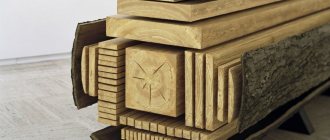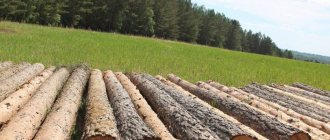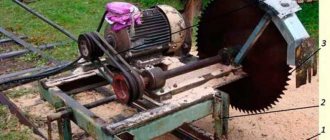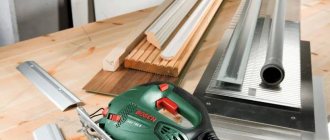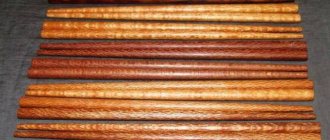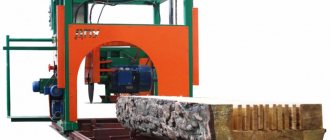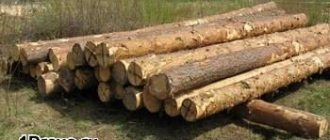When sawing round timber, boards, beams and sleepers of various sizes are obtained. The resulting amount of lumber is called the output. Manufacturers strive to obtain large quantities of product with a minimum of waste. Proper calculation allows you to obtain the highest yield of lumber from round wood on a band sawmill. This can be done using a log cutting map.
Introduction
This parameter is one of the most important indicators in sawmilling. The efficiency of sawing timber depends on this indicator. Many beginners mistakenly believe that the higher this ratio, the better.
In fact, this is not always the case; most specialists know about this, but remain silent. I repeat once again - a high percentage of lumber yield per cubic meter of forest is not always good. I described in detail why this is so in my book “Organization of sawmilling at a modern enterprise,” but for readers I will lift the veil on this issue at the end of the article.
This is a truly unique e-book, there are definitely no such books in Russia :-)! ! !
It provides simply colossal information gained from personal experience as a technologist in a large production.
[my_custom_ad_shortcode1]
Percentage of round timber
It is calculated by the formula: Kout = Vpil/VbrWhere K, % is the percentage of lumber yield.
Vpil , m3 - volume of lumber obtained. Calculated:
Vpil = L*H*B*n1+L*H*B*n2 + …
- where L is the nominal length of the finished lumber;
- H - board thickness;
- B - board width;
- n is the number of boards of each size.
Vbr , m3 - volume of logs from which lumber is obtained. It is determined by the cubature, which can be downloaded from me on this page.
The useful percentage of lumber in production is calculated for each diameter of the forest and for each sawing technology. I can only give general recommendations, and improvements need to be done in specific places.
[my_custom_ad_shortcode2]
Why does the useful percentage depend on the diameter of the wood being cut?
It's very simple, the fewer cuts to obtain wood, the higher the percentage. Of course, it also depends on the useful use, but once again I will say that it is very important how many saws you have to get a board. As a rule, small boards are cut from small wood, and timber or thick boards are cut from large wood.
The company's performance in the production of timber is especially good; its cubic capacity is good, sawing speed is maximum (there are fewer saws after all) and cutting tool consumption is minimal. Below are the approximate diameters with consumption rates:
- 12 - 16 cm - yield 45 - 50%;
- 18 - 22 - average 52%
- 24 - 26 - about 57%;
- 28 - 40 - this is timber timber and the best results are achieved when obtaining timber - 66%;
- 42 - 60 - in this range there was a decrease in the percentage of boards made from wood. Since this wood is used to produce boards and beams that are not so large, and therefore the number of cuts with a saw becomes many times greater.
These consumption rates are indicative and are valid for the production of such lumber as:
By type of equipment, these rates can be taken on a band sawmill, on sawmill frames and circular saw equipment.
[my_custom_ad_shortcode3]
Quantity of finished material, cutting price
The yield of useful material from coniferous and deciduous trees differs in percentage. The following indicators are typical for lumber obtained from coniferous trees:
- provided that the operation is carried out by a professional and a circular sawmill is used, the percentage of finished wood will be the highest (80-85%);
- the edged material produced by the machines averages 55-70%;
- When used with a chainsaw, an unedged board leaves up to 30% waste.
The figures are given without taking into account the finished culled timber, the amount of which can reach 30%. However, such material is used for products that allow certain defects.
Finished wood products after sawing
Deciduous round timber produces 60% of the finished unedged timber and about 40% of the edged timber. This is explained by the initial curvature of the round timber. It is possible to increase the amount of products obtained: this will require forest processing machines of various types. A certain kind of device can increase the amount of lumber by 10-20%. For one cube of lumber you will need about 10 cubes of deciduous round timber. The cost of installing additional equipment will be recouped by the cost of the finished timber. Special lines provide greater volume, but their use is only advisable over a large area. The average price of sawing wood at a regular sawmill will be approximately 150-180 rubles per cubic meter of boards.
Ways to increase the ratio
There are technological tricks, which I partially talked about in this article. But as they say, repetition is the mother of learning, here are some of them:
- Use of shorter commercial timber;
- Using specialized programs, read about it here. In short, we can say that you need to use the program to find the optimal cost of boards obtained from logs. On the one hand, a high useful yield means a large cubic capacity, and on the other hand, a high indicator means obtaining a larger volume of low-quality wood.
- The use of thinner saw blades due to double-spindle circular saws and the use of stellite tips.
- Use of sorting round timber by diameter, species, defects.
And now in more detail about everything. The shorter the wood, the higher the percentage of lumber obtained. In Europe they know this well and therefore the cutting lines there are calculated at 1.5 - 2 meters. Our sawmill frames can only cut 4-meter logs.
Using programs in production, we calculated our supplies for each season, increasing the amount of low-quality wood during periods of demand (summer, autumn), and increasing the amount of high-quality wood during periods of increased demand for them (winter, part of spring).
I think everything is clear about using a saw blade with the best characteristics. It is also necessary to monitor the quality of the resulting cutting tools. On frame and circular saws, you need to constantly monitor the presence of all solder tips, sharpening angles for each season, and rolling on both types of saws.
Sorting allows logs to be separated by diameter, defects and blemishes. For example, with rot in the core, then the log is sorted and sawed into lumber, instead of being turned into timber. Or vice versa, if the sapwood is rotten, but a beam emerges from the central part, and the log is a timber log, we sort it for sawing into timber. You need to think similarly in terms of blueness and curvature.
[my_custom_ad_shortcode4]
Selection of sawmill technology
Gate technology (sawmill frames)
Outdated technology
.
The equipment requires the installation of a multi-ton foundation. It is also necessary to sort the lumber into at least 12 standard sizes to optimize the yield of the suitable material coefficient. Needs constant re-adjustment
of saws. It has poor board geometry and high surface roughness. Cut thickness 5-6 mm. Most common sawmills have difficulty coping with the common saw log (saw log diameter more than 70 cm). The yield coefficient of suitable edged lumber is about 50-55%.
However, it has excellent cutting stability
, good performance, unpretentious in maintenance, does not require highly qualified sawyer. It still enjoys well-deserved popularity, producing products mainly for the unpretentious domestic market, where the cheaper the better. It cannot cut radial cut boards mainly due to poor accuracy.
Recommended
use if you have your own logging and a large amount of cheap raw materials of medium thickness. The undisputed leader among all technologies for the production of unedged lumber of medium quality.
Band saw technology
Relatively young technology. A steel strip welded into a ring has teeth cut on one or both sides. It is put on two rotating drums with a diameter of 0.5 to 1 m. The main thing is that the tape must be flexible enough to rotate for a long time and at the same time hard enough to cut for a long time and not become dull. Sometimes the teeth are hardened, or teeth from another metal are welded. It is necessary to distinguish between machines working with a narrow belt
20-60 mm wide and with
a wide tape
100-300 mm. The teeth on a narrow belt are set apart. The wide belt has flattened or stellited teeth.
Many band saws can cut logs with a diameter of more than 1 m. They do not require foundation equipment. Cut thickness 2-3 mm. Easily handles hard wood. They require lubrication: in summer - water, in winter - diesel fuel. As a rule, they have an individual cut and do not require subsorting of logs. Have the highest yield
suitable for edged lumber - up to 75%.
Farmer grade machines
on a narrow belt with a productivity of about 5 cubic meters per shift and are quite cheap. Middle-class machines on a 100-130 mm wide belt saw up to 10-15 cubic meters per shift and cost several times more.
Machines with narrow bands do not cut well
dirty and frozen wood.
They give you a corrugated board, and the saw becomes dull after just one cut on a dirty log. The cost of a decent saw is more than 25 dollars, and it can cut about 10 cubic meters of logs and becomes unusable. The technology has the highest unit cost
of tools per cubic meter of output and average cutting stability.
After two hours of sawing, the band saw should be removed and hung up to rest for a day to maintain fatigue strength. In reality, it turns out that to ensure two-shift operation of the machine on a narrow belt, about 100 saws
in year!
A highly qualified
sharpener and caution as a sawyer are required To repair it, they use quite expensive imported welding machines. Their use makes it possible to weld tape from literally meter-long pieces, which prolongs its life, significantly reducing tool costs.
Band saws
on a narrow belt, due to their low cost, most of the smallest sawmills and farmers have them. The main disadvantage of a narrow tape is the wavy cut, which greatly limits production possibilities. Therefore, this technology is only suitable for small business production, and without the possibility of growth.
It is more preferable to use horizontal band saws
with a tape 80-100 mm wide. Such belts have stellited teeth and are not afraid of dirty and frozen forests. These saws cost $200 and up. During their life, they can cut up to 300 cubic meters of lumber. However, such saws require a whole complex of equipment to maintain them in working condition, comparable in cost to the machine itself.
Horizontal sawmills
with a belt width of 80-100, it is recommended to use them as first-row machines in the presence of fairly thick and expensive raw materials, when the cost-effectiveness of its processing comes to the fore. For these purposes, of course, you should use machines with a belt width of 100 mm and above.
It is advisable to use band saw technology on narrow belts
e as machines of the second row. These are four-head and five-head multi-saws of the Avangard brand. This class of machines perfectly complements the currently widespread circular log sawing machines such as “Kara”, “Magistral”, and TsDS. It is quite difficult to make and perfect a wide band saw. Has reached a high level of skill in the production and preparation for work of wide band saws.
Circular, circular saw technology
Machines using this technology are divided into three types.
1. Vertical circular saws
With the beginning of market reforms, circular log sawing machines with large saws such as “Kara”, “Limet”, “Slidetek” came to us from Finland, allowing us to produce lumber of export quality
with an accuracy of 1-2 mm. Prototypes began to be produced in Russia: “Magistral SPR-1100”, TsDS-1100, etc.
All of them, as a rule, use saws with a diameter of 900-1100 mm. Price
one saw, depending on the degree of its preparation, ranges from 300 to 700 dollars. One saw can cut up to 3,000 cubic meters of edged lumber; it is sharpened directly on the machine. But once a week the saw requires balancing and shaping of the teeth. To do this, you will need a sharpening machine for circular saws or a semi-automatic sharpening machine, for example, TchPA-7 from the Kirov Machine Tool Plant. Steel saws get dull quite quickly. In winter they require sharpening 2 times per shift, and in summer up to 4-5 times per shift.
It is possible to use carbide
and
stellited
saws. Moreover, it is better to use carbide saws in summer, and stellited saws in winter. Maintaining the tool in working condition and producing boards with export geometry require a qualified sawmill. Most sawmills do not have these and produce boards that can only be sold on the Russian, unpretentious market.
The cutting width of a saw with a thickness of 4 mm is 6-10 mm. The cut is individual and does not require any sorting of diameters. The yield coefficient for edged lumber is actually 52-56%. If you saw through a slab onto a picket fence - 56-58%.
Circular technology has the highest cutting speed
: a six-meter log is cut in 8-14 seconds, a board is cut in 4 seconds. Productivity is quite high (up to 15 cubic meters per eight-hour shift). Allows you to work at temperatures down to -30 C o.
Accordingly, it has low tool costs
: 3-4 saws can be used for two years. Cutting stability is high when the log is not very dirty. The machine performs the functions of a product transporter around the workshop, which is not unimportant. The Russian machine has not very reliable, but easily accessible and inexpensive hydraulic elements: hydraulic motors, pumps, distributors. And most importantly, it is 3-4 times cheaper than its imported analogues, while, of course, it is inferior to them in reliability.
Recommended for use in small and medium-sized production facilities
as the basic elements of the first row. Suitable for both the production of finished edged lumber and for breaking logs into large pieces for further processing on highly economical band saw machines.
2. Angle saws
There is a whole class of circular log saws called “angle saws”
. This can be two or three saws installed at an angle of 90 degrees to each other. For example, machines “Grizzly”, “Bobr-2000”, DP-1200, “Vyatka 600”, “Alpha”. As well as machines with a single rotary saw blade, for example the Slovak UH500 and UP700. The Bars machine has two independent saws installed at an angle of 90 degrees, and unlike imported prototypes, it performs the functions of transporting lumber around the workshop.
Machines of this class have a number of undeniable advantages
: can cut logs with a diameter of more than a meter, having a yield yield of up to 70%; they use saws with carbide tips D = 500-800 mm of relatively low cost; cope well with dirty logs because they have carbide tips; require sharpening once a day or less; have unsurpassed cutting accuracy of 1 mm.
Recommended use
for processing thick gauge and primarily for the production of radial sawn timber. In particular, Slovak machines and Russian “Bars” are very good for radial sawing of larch into blanks for lamellas.
On the Russian market there are also inexpensive miter sawing machines with a rotating disk, which completely replace a band sawmill for a small business, but do not have problems with the geometry of the lumber - “Sever 550”, PDU1.
3. Horizontal circular saws
There is another type of circular saw, which confirms that the possibilities of circular technology are far from being exhausted. These are machines with a horizontal arrangement of two saws
in one plane. Representatives here are the Slovak machine KP58 and the Russian “Bars DG”, “Toima 600”.
Advantages
: the machines are quite powerful and can process logs with a diameter of up to 500 mm; there is no need to change saws frequently, they work for at least 24 hours without sharpening; productivity when using a log loader and tilter can reach 6-12 or more cubic meters per 8-hour shift; provide good surface quality and geometry of lumber.
As you may have guessed, there is no universal woodworking technology. The sawmill should be selected according to the raw materials that you are going to cut and the products that you are going to produce.
Vladislav Permin, especially for the site
EXPERT OPINIONS
Dmitry Bychkov, director of Kamsky Bereg LLC (www.kbstanok.ru):
The main selection criterion is operating costs per 1 cubic meter of lumber. Accordingly (other things being equal), the higher the productivity, the lower the cost.
Find professionals, study the experience of other industries, study the lumber market - demand is subject to seasonal fluctuations, profitability is, on average, low, and it is very difficult to work with purchased raw materials. Profitability also depends on the depth of wood processing. And remember: the sharpener is the most important worker, since the woodworker's profit is at the tip of the saw tooth.
I would also mention such a class of equipment as canter disk machines of the first row and multi-saw disk machines of the second row, of the pass-through type. In the Russian Federation, heavy timber beams (log diameter up to 500 mm) are now made by only two (Arctant) and we, Kamsky Bereg-Stankostroy (Vityaz 640M). If you need to process 100 cubic meters or more per shift, there are no other domestic production options. If the sawlog is up to 300 mm (fine gauge), you can use disc cutters for fine gauge (“Vepr 700”).
Circular saws are a reliable and widespread solution for serious business. Their use requires a high degree of mechanization of the site, but the cost of a mechanized integrated circular sawing line is quickly justified due to the high flow rate, low operating costs and high reliability of the equipment.
Arthur Zainutdinov, General Director of TF ExpoForm LLC (www.expoform.ru):
Nowadays, a wide range of woodworking equipment prevails on the Russian market, both from well-known and not so well-known manufacturers. When selecting it, first of all you need to look at the service support of the purchased equipment. Often, equipment is purchased with a very favorable price or configuration, and then problems begin with the supply of spare parts and service support. You should always choose as a supplier a company well-known on the market that supplies reliable equipment from a trusted manufacturer.
The second point that is worth paying attention to is the build quality, materials and components used in the manufacture of specific equipment. Budget equipment has an advantage at the stage when production is just opening and funds are needed for promotion, but you want to equip the production with all the necessary equipment as much as possible. But you must always remember that after some time the question of repairing or replacing equipment will arise.
It is no secret that most often we encounter poor quality when purchasing equipment from Southeast Asia, especially from China. There are also complaints about European manufacturers whose production or assembly sites are located in the above regions.
It is important to remember that good quality equipment is also valued on the secondary market and it is always easier and faster to sell it. Therefore, sometimes it is better to buy the desired machine from a well-known manufacturer on the secondary market than to purchase a new machine, painted in bright colors, with shiny handles and a lot of bells and whistles of dubious quality.
Before sawing round timber, it is necessary to calculate how much volume will be left for further use, and how much material will be spent on processing. This is important because it affects the final cost of the product. The amount of untrimmed wood you get will depend entirely on what type of wood is used. At the same time, there are certain measures to increase the yield of lumber after cutting.
Approximate yield by variety
The situation regarding varieties is quite interesting. It turns out that the percentage of yield of high-grade products depends on the following factors:
- The coefficient of production of lumber from round timber. Grade depends not directly, but indirectly. The fact is that after some golden mean, the more planks we get per cubic meter, the higher the amount of low-grade wood with wane;
- The larger the diameter, the higher the likelihood of getting more high-quality boards;
- The presence of wood defects, such as curvature, rot, blueness and others; the fewer there are, the higher the percentage of obtaining a high-quality board;
- The shorter the finished product, the higher the percentage of high-quality boards.
Now let’s estimate, approximately based on the diameter, the percentage of first-class lumber obtained from the total volume of boards produced. To do this, I made everything in the form of a small table. Table 1 - yield of boards when sawing round timber.
| Diameter, cm | Yield of premium grades, % |
| 12 — 16 | first grade yield 40% |
| 18 — 22 | on average 50% |
| 24 — 26 | about 50% |
| 28 — 40 | log timber, during the production of timber you can get indicators of about 70% |
| 42 — 60 | about 60 - 70% |
[my_custom_ad_shortcode5]
Amount of wood waste
During the sawmilling process, various pieces of waste are obtained, which in some cases are used for energy purposes.
Lump sawmill waste is formed from the peripheral part of the logs and, in the absence of preliminary debarking of the logs, contains such an amount of bark that it is impossible to use it for pulping and the production of wood-based panels.
The volumes of formation of various types of wood waste as a percentage of the volume of sawn raw materials are given in table. 14. Name of logging waste Including 13. Amount of waste generated during logging production Amount of waste per 1000 m1 of annual warehouse turnover, m3 Amount of waste from exported wood, % At the cutting site A. Solid or lump from Moves: Branches, twigs, tops 14, 00 140 65 75 Roots 11.00 110 .
110 — Stumps 3.00 30 30 — Points 1.75 17 — 17 Visors 0.75 7 — 7 B.
How does the percentage of lumber production depend on sawing technology?
In addition to diameter, grade, defects (curvature) and length, the percentage of board yield depends on the technology of sawing wood and the type of equipment. There are two types of sawing technology:
- Individual cutting, the percentage of useful yield approaches 75%;
- Group cutting, depending on other parameters, the useful yield can also reach 70%.
And the equipment for sawing can be the following:
- Band sawmills produce lumber products with minimal wood consumption rates;
- Tire sawmills produce lumber with increased consumption when sawing logs, since the thickness of the chain is much greater than the strips.
- Sawmill frames. It is quite inconvenient to process thin wood using this type of equipment. Therefore, sawing is mainly done from a diameter of 20 - 22 cm;
- Milling canter lines. This type of equipment has both an advantage and a disadvantage over other technologies. He only cuts graded wood;
- Circular saw equipment cuts according to individual cuttings - this is a big plus for the resulting materials, both in quality and quantity.
[my_custom_ad_shortcode6]
Choosing the type of sawmill
Now on the Russian market there are band
,
disk
, and
frame
sawmills.
In order to compare the efficiency of their work, we will use such a parameter as the percentage of finished lumber yield
.
The maximum indicator in this comparison is for band sawmills, which give 82-88%. For comparison: the frame sawmill has only 61%. The second very important point: what types of forest
does this or that sawmill work best with. For band sawmills, these are fine-grain and medium-sized wood; disc sawmills cut large wood well, but face big problems when sawing fine-grain wood; and a frame sawmill will not be able to saw a log larger than 480 mm in diameter.
A cutting plan is drawn up for the entire volume of raw materials intended for processing within a month or per 1,000 m3 (while maintaining the specific ratios of the size and quality of the logs specified in the specification for the month) (Form 3.3). Based on it, a schedule for sawing raw materials is drawn up, taking into account the possibility of sorting it and the timing of delivery of lumber products to consumers.
Video on the topic
And now I’ll answer why a high yield is not always good, but everything is simple at very high rates, the amount of boards with wane increases.
The result is low-grade lumber and its total cost from a log at a certain point becomes lower than the cost of high-quality materials. And selling low-quality material can be more difficult.
Good luck and see you again, Andrey Noak was with you.
When creating a business plan and its subsequent correction, wood processing enterprises always calculate the norms for the yield of lumber when sawing.
When receiving logs, wood processing enterprises always calculate the rate of lumber yield when sawing.
Each country has its own standards, but they are given extremely vaguely, because more accurate characteristics can only be obtained on an individual basis.
[my_custom_ad_shortcode1]
Pay attention to the little things
To buy wooden products and not overpay to an unscrupulous seller, use the formulas provided and independently calculate the required number of boards. A simple example: you received the actual volume of 1 element 0.035 m 3. Suppose 1 cube costs 6,000 rubles, then the board will cost 210 rubles. But if the seller rounds thousandths to hundredths, it comes out to 0.04 m 3, then you will have to pay 240 rubles for the product. Maybe for one board the difference is not so significant, but often lumber is purchased in large quantities, and then the difference in price can cost several hundred rubles. It is advisable to know for sure how many boards are in a cube.
Basic information
The volume of finished lumber when sawing is, first of all, determined depending on the technological waste. The latter also depend on many factors. It is very important to take into account the quality of the original lumber, i.e.
when sawing logs, the following boards are obtained:
Cutting logs into boards: 1 - core; 2 - central; 3 - lateral; 4 - slabs.
- Core ones. They are cut from the very center of the trunk, and due to the fact that it is the core that is characterized by increased strength and resistance to all influences, these boards are the most valuable.
- Central. They can be radial or tangential, depending on the cutting style. Both options have their pros and cons, which is why the demand for them varies slightly. It is these boards that are used in almost every line and in furniture manufacturing factories.
- Lateral. For craftsmen, such boards are more valuable, but they also cost more. The area of the side boards is located between the central part and the slab. The main characteristics are less knotty, easy to plan, cleaner surface. But they are obtained this way exclusively from the butt part of the tree.
A lot depends on the degree of processing of the lumber, on the quality of the equipment and its technical condition; the qualifications of the craftsmen are also not the least important, and at the same time a number of smaller factors. Losses during sawing lumber are divided into 2 types - returnable and irrecoverable, and all over the world craftsmen try to minimize the latter in order to put everything into action down to the smallest detail.
Return losses include slabs, shavings, boards of incorrect length and width, sawdust, and lump waste. Irreversible - bark that cannot be processed and is almost impossible to sell, i.e. the only use is a stove or, in some cases, pharmaceuticals (many medicines are made from the bark of many trees, but how the bark is obtained does not matter).
[my_custom_ad_shortcode2]
Additional aspects
Sawdust is used to make chipboard. For a long time, masters could not determine what to do with waste, but since the 18th century, targeted experiments have been carried out, bearing fruit:
- Boards and timber of non-standard length are ideal for the manufacture of finishing materials and furniture panels. In fact, the restriction by GOSTs gave rise to a new direction of engineering and design thought, which was picked up all over the world due to its accessibility. Starting from the middle of the 20th century, widespread use began with the accelerated mutual exchange of technologies, due to which this type of waste became very conventional; a number of manufacturers even highlight them in a separate column as a full-fledged material when creating price lists.
- Sawdust. Chipboard material is known all over the world, from which 90% of the furniture on the planet is made. Chipboard is made from sawdust mixed with a number of resins and adhesives. With some investment, these losses also became returnable, although they were the ones that seemed the most terrible. They did the same with the chips, only the processing method was completely different, which is why the material acquired different properties (it is used much less frequently).
There are also statistics that give average figures for conifers:
| Lumber | European part of the Russian Federation, % | Asian part of the Russian Federation, % |
| Board from 1 m and above | ||
| Short board | ||
| Lagging | ||
| Technical wood chips | ||
| Sawdust | ||
| Waste | ||
| Drying and spraying |
Table of wood types.
For such a yield of lumber, modern high-precision equipment is not required, just as circular saws are not needed. The indicators are given exclusively for chain obsolete units, which were used in the USSR and are quite popular in the 21st century. Modern technology, in turn, can increase efficiency from 54.7 to 60-61%. If the equipment is severely worn out, then the efficiency will drop to 10%, which entails serious losses of wood, including financial ones.
Some masters try to prove that it is possible to achieve efficiency of up to 80%, but even with the most modern programs such a construction is technically impossible. To increase the yield of lumber when sawing, you need to regularly check and modify the equipment, and, if necessary, update it.
Another significant factor is the type of wood. The higher the grade, the higher the % yield. For example, it is always more convenient to saw maple than its peer pine.
In pine, the efficiency will drop to 35-45%, because the trunk is very narrow. That is why logging organizations try to work exclusively with old trees, the sawing of which will bring maximum benefit.
[my_custom_ad_shortcode3]
Making the calculations easier
In order not to determine the volume of products individually each time, you can use ready-made data. Manufacturers have calculated how many boards are in a cube: a table compiled from the measurement results helps determine the required amount of material. Such directories contain data on different types of products; they are grouped according to main sizes. There are separate reports for boards, beams, platbands, baseboards and others that exist today; they are actively used not only by ordinary people, but by design engineers and builders.
Now let's look at how many boards are in 1 cube. The table is compiled for edged products.
| Height*width*length, mm | V 1 boards, m 3 | Whole pieces in 1 m 3 |
As you can see, the reference book provides the exact number of boards in a cube. The table takes into account fractions up to thousandths, which are important to take into account when purchasing and other calculations.
Summarizing
To maximize the yield of lumber, you need to cut using modern equipment with the support of qualified personnel. You shouldn’t even try to calculate waste when sawing, because...
in each individual case it is different, but it is quite possible to use the figure of 50%, which will be minimal on any equipment. Thus, even if sawing does not bring the desired results, the calculated ones will be confirmed in any case, i.e.
Progress does not stand still and there are almost no unrealizable materials left, and the bark can be taken for an error of 2-5%.
- The calculation should be carried out only when using special programs; manually it will have low results, and the percentage of defects will be high.
- The round timber must first be sorted so that processing is carried out correctly.
- For cutting it is necessary to use high quality equipment. Otherwise, the amount of waste will be large, and the quality of the resulting lumber will be low.
- It is best to cut wide lumber first; narrow lumber takes longer to process.
- It is not recommended to take long logs.
- Before work, you should set up the equipment.
In order for the finished board to come out with a high percentage, everything must be prepared correctly, the work must be carried out only in accordance with the technology. Roundwood of coniferous and deciduous species produces different yields. In the latter case, the volume is smaller, even if special additional equipment is used. Needles are considered more convenient for sawing, since their trunk is straight and the log has a larger diameter. Coniferous forest is not so susceptible to rotting, so there is less waste. For hardwood, 2 cutting technologies are usually used:
[my_custom_ad_shortcode4]
Manual work: using a chainsaw
For home cutting of several trunks, it is not advisable to purchase a tool whose cost is several times higher than the price of finished products. If you have the necessary skill, then it is more efficient and cheaper to do all the necessary work with a conventional chainsaw or chain equipment powered by electricity. Of course, such work requires much more physical effort and time, but the cost of the issue is significantly reduced. Work on a garden plot requires pruning of fruit trees, and it also becomes possible to additionally produce material for outbuildings without resorting to the services of specialists, so any zealous owner would prefer to buy a chainsaw. Most often, coniferous wood is harvested for the home, and this tool does an excellent job of cutting it. Thanks to straight trunks, it is easier to mark cutting lines, which increases the speed of work. Professionals, by the way, most often use a chainsaw, since it is more powerful than an electric one and can be used anywhere, regardless of whether there are power sources at the cutting or cutting site.
To use a chainsaw to cut logs, you will need a device such as a saw attachment, as well as cutting guides and base-trunk fasteners. The frame-shaped attachment is attached to the tool so that it remains possible to adjust the distance between the chain and the frame itself. This is done to make it possible to produce finished lumber of different thicknesses. For the role of a guide, you can take either a profile of the required length, or a flat wooden plank with sufficient rigidity. A special chain is selected for the tool, designed to cut the trunk lengthwise. Its difference from the others lies in the teeth, sharpened at a certain angle. Before you start working, you must not only prepare all the necessary tools. Regardless of whether a woodworking machine or a manual device is intended for processing the trunk, the first thing you need to do is familiarize yourself with the cutting map. This is done in order to minimize the percentage of waste and increase the yield of useful products. The first thing you need to worry about when longitudinal cutting is the uniform density of the finished boards. To do this, a competent sawyer directs the tool from the east side of the log to the west, or in the opposite direction. This is explained by the higher density of round timber in its northern part than in the southern part.
Next, use a chainsaw to remove the slab from both sides so as to obtain a double-edged beam. It, in turn, is sawed in accordance with the cutting pattern chosen at the beginning of the work. The solution is an unedged board. If there is a certain percentage of defects in the trunk, then a circular cut is possible with the trunk turning at a right angle or 180°.
- State Forestry Committee 51
- Gosleskhoz 35
- forest industry 10
- timber carrier 16
- State Agency of Forest Resources 3
Output of lumber from roundwood - by grade and depending on the diameter of the logs
It's very simple, the fewer cuts to obtain wood, the higher the percentage. Of course, it also depends on the useful use, but once again I will say that it is very important how many saws you have to get a board. As a rule, small boards are cut from small wood, and timber or thick boards are cut from large wood.
- Use of shorter commercial timber;
- Using specialized programs, read about it here. In short, we can say that you need to use the program to find the optimal cost of boards obtained from logs. On the one hand, a high useful yield means a large cubic capacity, and on the other hand, a high indicator means obtaining a larger volume of low-quality wood.
- The use of thinner saw blades due to double-spindle circular saws and the use of stellite tips.
- Use of sorting round timber by diameter, species, defects.
[my_custom_ad_shortcode5]
Equipment and tools
The choice of means for processing wood is influenced by the quantity of the planned product and its quality. The following tools can be used in logging:
- With a circular saw you can make cuts in any direction. The tool copes with any thickness of logs. The saw is used both at home and in production.
- A chainsaw is used in cases where it is necessary to process small volumes of lumber. Most often used on private farms. For ease of operation, it can be equipped with cutting guides and log holders.
- The band sawmill produces a large volume of high-quality wood. Its advantage is the low percentage of waste at the output.
- A special feature of the frame sawmill is its mobility. It can be moved freely to any location and can be installed in close proximity to logging sites.
- A disc machine is used to produce unedged material.
- In production, a bark stripping machine is often used. The tool has a high cost, but is quickly purchased due to its efficiency.
When there is a small amount of round timber, a circular saw is most often used. For industrial scale, there are entire complexes that allow processing wood of any quality.
Current norms for lumber yield when sawing
- Boards and timber of non-standard length are ideal for the manufacture of finishing materials and furniture panels. In fact, the restriction by GOSTs gave rise to a new direction of engineering and design thought, which was picked up all over the world due to its accessibility. Starting from the middle of the 20th century, widespread use began with the accelerated mutual exchange of technologies, due to which this type of waste became very conventional; a number of manufacturers even highlight them in a separate column as a full-fledged material when creating price lists.
- Sawdust. Chipboard material is known all over the world, from which 90% of the furniture on the planet is made. Chipboard is made from sawdust mixed with a number of resins and adhesives. With some investment, these losses also became returnable, although they were the ones that seemed the most terrible. They did the same with the chips, only the processing method was completely different, which is why the material acquired different properties (it is used much less frequently).
Return losses include slabs, shavings, boards of incorrect length and width, sawdust, and lump waste. Irreversible is bark that cannot be processed and is almost impossible to sell, i.e. The only use is a stove or, in some cases, pharmaceuticals (many medicines are made from the bark of many trees, but how the bark is obtained does not matter).
[my_custom_ad_shortcode6]
Output of edged lumber per 1m³
The ends of lumber and rough blanks must be sawn at right angles to the longitudinal axis. Wane beams (with a partial absence of a cut in the edge) with a cross-section of 120×120 mm or more must have a cut width at the thin end of at least one third of the side of the beam. They are made in various assortments, sizes and quality.
Interesting: What needs to be done for divorce By sawing logs crosswise, lumber is obtained that differs sharply from each other in quality and appearance. Those taken from the middle of the trunk are called core. The wood of these boards is the most durable and stable. “Lateral” are called boards obtained from the extreme parts of the trunk. They have a beautiful texture and are used for finishing work. They cannot be used in load-bearing structures, because boards are easily deformed.
[my_custom_ad_shortcode1]
Determining the percentage of lumber yield when sawing timber, in particular round timber
Note! Coniferous wood is considered the best option due to the fact that they have a straight trunk and a relatively larger diameter. In addition, such wood is not as susceptible to decay, which leads to less waste.
- 14 – from 45 to 50%;
- 20 – about 52%;
- 25 – on average up to 57%;
- 34 – this is the diameter of lumber, which has the highest volume fraction of 66%;
- if the forest has a diameter of more than 40 cm, then there is a sharp decrease in the materials obtained.
[my_custom_ad_shortcode2]
Stages of sawing round timber
To obtain a high percentage of lumber from round logs, several different technologies are used, including certain cycles of actions. The time required for sawing round timber and the labor intensity of the process varies, depending on the chosen processing method, the location of the work, and the season. Thus, some enterprises build workshops for the primary processing of raw materials near the timber harvesting site and save on this.
Circular - after sawing off one or more unedged boards, the log is rotated 90 0 and the following boards are sawed off. This method is used when a large log is affected by heart rot in the center. With its help, healthy wood is separated from low-quality wood.
[my_custom_ad_shortcode3]
Types of lumber
Today, wooden products for construction are presented in a wide variety of variations: components for the construction of walls and individual structures (beams, logs), various panels (fibreboard, chipboard, OSB), elements for finishing and cladding. Therefore, it’s worth starting with what the boards can be:
How many boards in a cube of any type are determined in the same way, regardless of the type of wood and the degree of processing. Exceptions are unedged boards. Next, we will consider calculation methods.
How to optimize the yield of lumber from roundwood
- The calculation should be carried out only when using special programs; manually it will have low results, and the percentage of defects will be high.
- The round timber must first be sorted so that processing is carried out correctly.
- For cutting it is necessary to use high quality equipment. Otherwise, the amount of waste will be large, and the quality of the resulting lumber will be low.
- It is best to cut wide lumber first; narrow lumber takes longer to process.
- It is not recommended to take long logs.
- Before work, you should set up the equipment.
- For unedged boards and other unedged materials during sawing, the yield will be 70%. This is the amount of material obtained during processing, the amount of waste will be equal to 30%.
- For edged material, when using sawmills of 63, 65, 75, there will be a lower yield of lumber, only around 45%. For band sawmills, the yield is usually up to 55-60% of the finished material. If you use means to increase efficiency, you can reach 70%, although this requires extensive experience.
- From a circular sawmill you can get lumber in the amount of 70-75%, although using methods to increase efficiency it may well be 80-75%. But work experience is required.
[my_custom_ad_shortcode4]
Types of wood cutting
Before you start cutting logs, you need to decide on the quantity and type of future lumber. Cutting can be carried out according to the following schemes:
- Waddle. As a rule, it is produced on trunks of medium thickness, mainly deciduous trees. During cutting, the log is passed through the sawmill once. The result is unedged boards and slabs.
- Sawing wood with lumber. The log is passed through the frame 2 times. First, unedged material and timber are cut out. Then the timber is sawn, producing edged and unedged boards.
- Segmental or sector method. Allows you to obtain up to 8 different elements from one barrel that meet the necessary requirements. The log is divided into sections, which are subsequently sawn in a tangential or radial direction.
- Circular method. During processing, the wood is rotated 900 after each pass through the frame. This method allows you to remove defective areas of wood in a timely manner.
In addition to cutting lumber, there are several types of sawing:
- Radial. With this method, sawing occurs perpendicular to the trunk, across the annual rings. The board turns out to be of excellent quality with an even pattern. The downside is the low yield percentage.
- Tangential. The cut is made along a tangent line relative to the growth rings. Thus, a board with different patterns is obtained.
- Rustic. The cutting is done at different angles. Wood defects are often visible on the cut of the board. This method is used to produce cheap materials.
In production, the method of cutting and sawing round timber is reflected in the technological map. It is drawn up before starting work and will allow for preliminary calculation.
